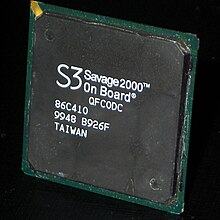S3 Savage
Savage is a name of the companies S3 Inc. and S3 Graphics for several 3D graphics chips. S3 Inc. had only moderate success with these chips due to massive driver problems.
Graphics chips
- S3 Savage 3D ( 1998 ): 8 MB, AGP 1.0, two versions: 390 and 391 (with Macrovision )
- S3 Savage 4 ( 1999 ): 32 MB, AGP 2.0, multiple versions: LT, GT, Pro and Pro +
- S3 Savage 2000 ( 2000 ): 32 MB, AGP 2.0, bad T&L unit
- S3 Savage XP ( 2002 ): 64 MB, AGP 2.0, revised Savage 2000
| Graphics chip |
Launch | Manufacturing process |
Number of transistors |
Core clock | Pixel pipelines |
TMU | Memory clock | Storage interface |
Memory size |
|---|---|---|---|---|---|---|---|---|---|
| Savage 3D | June 1998 | 0.25 µm | 100 MHz | 1 | 1 | 125 MHz | 64 bit | 8 Mbytes | |
| Savage 4 | 1999 | 0.25 µm | 110 ... 166 MHz | 1 | 2 | 100 ... 166 MHz | 64 bit | 8 ... 32 Mbytes | |
| Savage 2000 | August 2000 | 0.18 µm | 12 million | 125 ... 150 MHz | 2 | 4th | 143 ... 166 MHz | 128 bit | 32 ... 64 Mbytes |
| Savage XP | 2002 | 0.15 µm | 166 MHz | 2 | 4th | 166 MHz | 128 bit | 32 ... 64 Mbytes |
Savage 3D
At the Electronic Entertainment Expo 1998 S3 Inc. introduced the first Savage chip: Savage 3D . Compared to its predecessor, the Trio3D descending from the ViRGE family, it was a major technical advance. Its innovative features included the following:
- "Free" (single-pass) trilinear filtering
- Hardware motion compensation and subpicture alpha blending ( MPEG-2 video)
- Integrated NTSC / PAL TV encoder, Macrovision (with 391)
- S3 Texture Compression (S3TC), texture compression
- BITBLT and overlay video acceleration
To the chagrin of S3 Inc. the production yield of the Savage 3D was too poor and only a few graphics chips could be shipped. Only Hercules brought a large number of graphics cards with the chipset onto the market. Along with bad drivers, Savage 3D failed in the market.
Savage 4
In early 1999, S3 Inc. withdrew the Savage 3D from the market and replaced it with the Savage 4 family. Many negative points of the Savage 3D have been revised: An additional TMU made multi-texturing possible in one pass. More video memory could be addressed and AGP 4x was supported. Despite everything, the new chips like 3dfx Voodoo3 or nVidia Riva TNT2 were faster, but the Savage 4 still offered a unique combination of 32-bit rendering and S3TC (texture compression).
The Savage 4 has been used by many manufacturers, including a. by Diamond Multimedia and Creative Labs . The 32-bit rendering, S3TC and the trilinear filtering offered the best quality at the time. In terms of DVD acceleration, it was second after the ATI Rage 128 . Despite everything, Savage 4 came out too late.
Savage 2000
In August 1999, S3 Inc. announced the Savage 2000 , which was installed exclusively on the Diamond Viper II . In terms of technical data, the chip was on par with Nvidia's GeForce 256 , but the Savage 2000 had many hardware bugs. B. the T&L unit not. The drivers themselves were again very bad and so the Savage 2000 was far inferior to the GeForce 256. As a result, the chip barely sold and as a consequence of this failure, S3 Inc. left the graphics business.
Savage XP / AlphaChrome
Only the newly founded company S3 Graphics reported back in 2002 with the Savage XP developed as Zoetrope . In the notebook sector, the chip was known as AlphaChrome , but it was completely identical to the Savage XP.
The Savage XP was basically just a repaired and slightly reworked Savage 2000. So it was much too late on the market to find high sales. Only with the successor DeltaChrome was S3 Graphics able to gain a foothold again.
IGPs
It was also S3 Graphics who began to integrate Savage 4 graphics cores into chipsets from VIA Technologies . These integrated graphics processors ( IGP ) were sold in large numbers and were only replaced by the UniChrome IGPs after some time.
| chip | Pixel pipelines |
TMU | Storage interface |
|---|---|---|---|
| Twister | 1 | 2 | 64 bit |
| ProSavage / ProSavageDDR | 1 | 2 | 64 bit |
Twister
The first result of this work were the Twister chipsets with SDRAM memory controller for AMD and Intel processors. A pure Savage 4 graphics core was integrated into these IGPs .
ProSavage
As the next stage in ProSavage , the 2D part of the Savage 2000 was combined with the 3D part of the Savage 4 and integrated into the corresponding SDRAM chipsets. This greatly enhanced the 2D features. Above all, DVD playback and the like have been significantly improved.
ProSavage DDR
ProSavage DDR was a ProSavage graphics core with DDR-SDRAM memory controller. Otherwise there were no changes.

